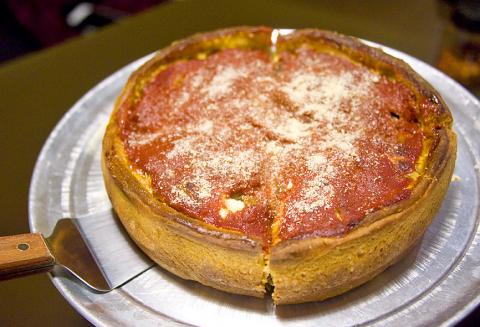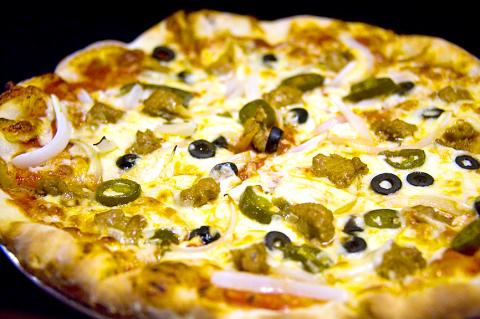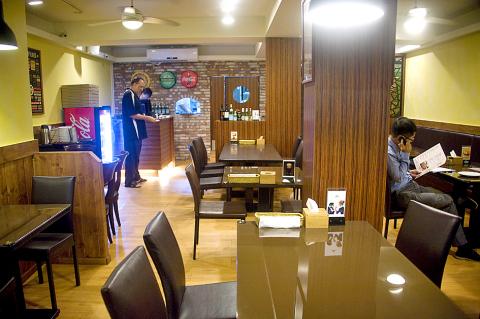The first time I walked past Big Boyz Pizza about a year ago, I jumped at the sight of Chicago-style deep dish pizza on the menu. While studying and working in the neighboring state of Missouri, there were ample opportunities to visit the Windy City and sample its signature pie.
Unfortunately, the owner, who received his training in San Francisco, told me that you had to order the pizza six hours in advance. As someone who makes spur-of-the-moment gastronomic decisions, I left dejected and never came back.
A year later, still craving the pizza, I decided to plan out a visit with a friend — and was delighted to find that the six-hour wait had been shortened to one hour. Now eating here is much more feasible — but I try to space out my visits, as it is heavy stuff even for American food.

Photo: Han Cheung, Taipei Times
The menu is simple, featuring Chicago and New York style pies — two of the most contrasting American twists on the Italian dish (we’ll leave novelties such as chocolate-and-marshmallow pizza out of the conversation here).
The appetizers are exclusively deep fried — chicken nuggets (NT$89), calamari rings (NT$99) and so on.
The more common New York pizza employs a thin, hand-tossed crust with a light layer of marinara sauce topped with mozzarella cheese. The crust is pliable, and the slices are often folded in half while eating.

Photo: Han Cheung, Taipei Times
The Chicago variety is closer to literally being a pie — the crust is about 5cm deep but not too thick. The toppings are reversed — you have the vegetables and meat first, then the mozzarella, then the marinara sauce topped with Parmesan cheese.
Don’t balk at the price for an 8-inch Chicago pie (between NT$669 and NT$799). Because of the pie’s thickness, one is enough to feed two, or even three hungry diners. The restaurant asks how many people are coming beforehand and cuts the pizza accordingly.
There’s no other way but to go all out, so we ordered the No 1 Chicago pizza (NT$799), which is stuffed with Italian sausage, bacon, pepperoni, peppers and onions.

Photo: Han Cheung, Taipei Times
The chicken nuggets came first. Nuggets are hard to review as they never resemble real chicken, but I would have to say Big Boyz’s were rather tender and flavorful.
There’s no fit-all for Chicago pizza, as each shop I’ve visited has varied quite a bit — but as far as general impressions go, Big Boyz is pretty spot-on. The sauce has the right amount of sourness and is not too sweet, though it could be a little chunkier. The cheese, served in a thick, generous layer, is soft yet stretchy, and meshes well with the textures of the variety of meat and vegetables. All of this is balanced out with the crust, which is just crispy enough with bits of cornmeal-like crunch.
Eat it fast, though, or the copious marinara will quickly sog the bottom.
Each bite is a different surprise due to the amount of ingredients — the bacon is more of a thinly sliced “Canadian” variety that resembles ham, but is lean and gives a nice rough texture compared to regular ham. The homemade sausage spiced with cumin is probably the best feature of the meal. Coarsely-ground, you can taste the granules of meat, and the cumin spice complements the savory meat juice perfectly.
For the second pizza, we ordered a New York-style South of the Border pizza (NT$369 for a 12-inch). It was decent — but nowhere as good as the Chicago style. The jalapenos provide a nice, sour kick, but maybe a bit more marinara could be used to balance the flavor. Much of the sweetness is provided by the onions, which made the slice too sweet in some places.
The crust was true New York style — light, aromatic and crispy, but the chorizo was a bit too similar to the Italian in flavor, and less appealing in texture.
Personally, I would stick with the Chicago pizza for this place — even if you just happen to stumble in, the one-hour wait is worth it.

April 28 to May 4 During the Japanese colonial era, a city’s “first” high school typically served Japanese students, while Taiwanese attended the “second” high school. Only in Taichung was this reversed. That’s because when Taichung First High School opened its doors on May 1, 1915 to serve Taiwanese students who were previously barred from secondary education, it was the only high school in town. Former principal Hideo Azukisawa threatened to quit when the government in 1922 attempted to transfer the “first” designation to a new local high school for Japanese students, leading to this unusual situation. Prior to the Taichung First

The Ministry of Education last month proposed a nationwide ban on mobile devices in schools, aiming to curb concerns over student phone addiction. Under the revised regulation, which will take effect in August, teachers and schools will be required to collect mobile devices — including phones, laptops and wearables devices — for safekeeping during school hours, unless they are being used for educational purposes. For Chang Fong-ching (張鳳琴), the ban will have a positive impact. “It’s a good move,” says the professor in the department of

On April 17, Chinese Nationalist Party (KMT) Chairman Eric Chu (朱立倫) launched a bold campaign to revive and revitalize the KMT base by calling for an impromptu rally at the Taipei prosecutor’s offices to protest recent arrests of KMT recall campaigners over allegations of forgery and fraud involving signatures of dead voters. The protest had no time to apply for permits and was illegal, but that played into the sense of opposition grievance at alleged weaponization of the judiciary by the Democratic Progressive Party (DPP) to “annihilate” the opposition parties. Blamed for faltering recall campaigns and faced with a KMT chair

Article 2 of the Additional Articles of the Constitution of the Republic of China (中華民國憲法增修條文) stipulates that upon a vote of no confidence in the premier, the president can dissolve the legislature within 10 days. If the legislature is dissolved, a new legislative election must be held within 60 days, and the legislators’ terms will then be reckoned from that election. Two weeks ago Taipei Mayor Chiang Wan-an (蔣萬安) of the Chinese Nationalist Party (KMT) proposed that the legislature hold a vote of no confidence in the premier and dare the president to dissolve the legislature. The legislature is currently controlled